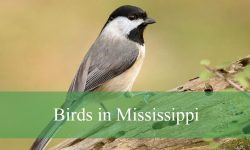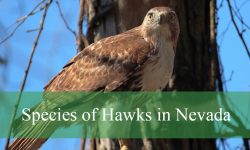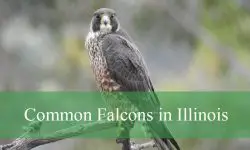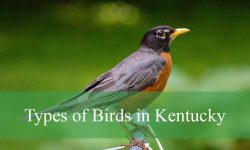A wide variety of green spiders may be found in Florida, which contributes vivid colors to the state’s ecology. The American green crab spider (Misumessus oblongus), the Magnolia green jumping spider (Lyssomanes viridis), and the green lynx spider (Peucetia viridans) are a few of the noteworthy species. In addition, Floridian settings are frequently home to the Triangle Crab Spider (Ebrechtella tricuspidata) and the Cucumber Green Spider (Araniella cucurbitina). The state’s high biodiversity of green spiders is enriched by the diversity of sizes, colors, and behaviors exhibited by these spiders.
Join us to learn about the 34 types of green spiders below, many of which can be found in Florida.
Different types of Green Spiders in Florida
Lesser Green Lynx Spider
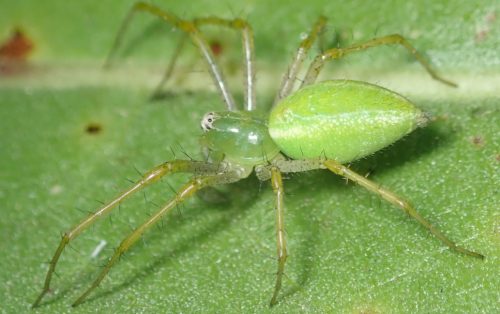
The Lesser Green Lynx Spider, scientifically known as Peucetia longipalpis, stands out as one of the prevalent green spiders in Southern US states, particularly flourishing in shrub plants across Florida. Recognizable by its green cephalothorax and legs, females exhibit a yellow abdomen, while males boast a green abdomen with yellow stripes. Typically found in open fields with shrub-like flowers or cultivated gardens, these spiders, although occasionally present in suburban areas, are not aggressive and are not known for biting humans. Their presence adds a touch of nature to these outdoor environments without posing a threat.
Green Lynx Spider
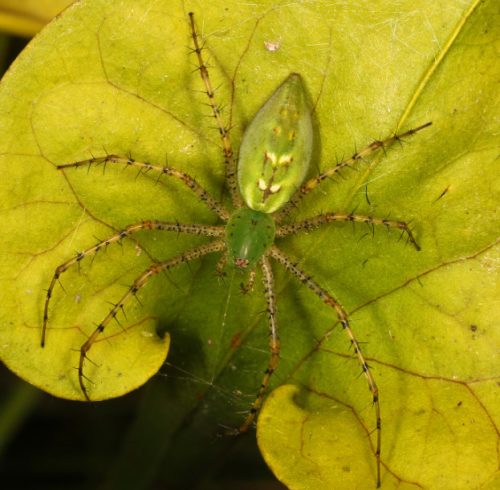
The Green Lynx Spider, scientifically known as Peucetia viridans, is a arachnid that can reach sizes of up to 2.2 cm (0.87 inches) for females and 1.2 cm (0.47 inches) for males. Characterized by a distinctive red patch between their eyes and red spotting on their bodies, these spiders have white-haired eyes and a uniquely patterned abdomen with six chevrons pointing forward. Their yellow and black legs add to their striking appearance. Notably, they undergo a seasonal transformation, shifting from green to pale yellow with streaks of red. Gravid females adapt their color to seamlessly blend into their surroundings.
Magnolia Green Jumping Spider
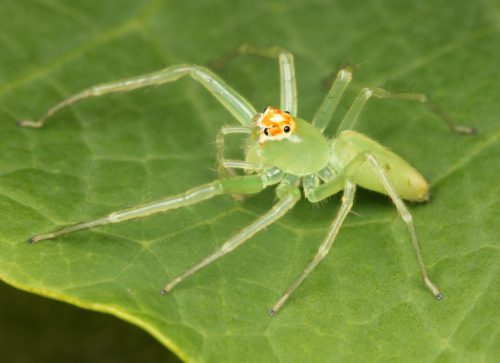
The Magnolia Green Jumping Spider, scientifically labeled Lyssomanes viridis, is a petite arachnid, with females reaching approximately 8mm and males about 6mm in size. Displaying a predominantly pale, almost translucent green hue, these spiders feature a delicate fringe of red, orange, yellow, or white scales adorning the crown of their heads. Their disproportionately long legs serve as powerful jumping mechanisms, enabling them to leap up to four times their body length. Notably, their vibrant pincers, brightly colored, double as formidable weapons, adding an intriguing aspect to their appearance and behavior.
Spotted Orbweaver
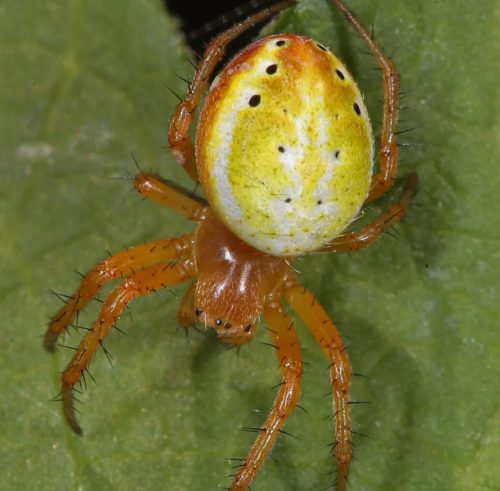
The Spotted Orbweaver, scientifically named Neoscona scylloides or commonly known as the Barn spider, is a widespread species found across North America, Europe, and parts of Asia, including Japan. Displaying diverse colors, the majority feature a green abdomen, possibly with yellow stripes along the edges, complemented by brown or yellow spots. The cephalothorax varies between brown and green, while legs can be green, brown, or black. With notably long first legs, these spiders are frequently observed in gardens and around man-made structures, particularly on farms, where they thrive due to the abundant insect presence.
Green-Legged Orbweaver
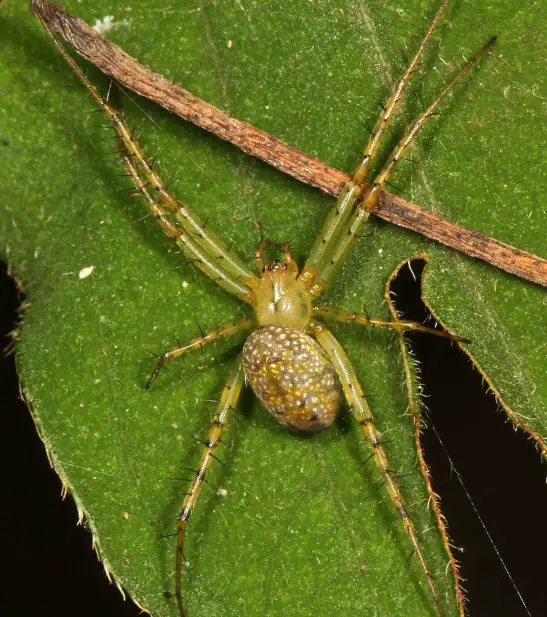
The Green-Legged Orbweaver, scientifically identified as Mangora maculata, is among various green orbweavers. Characterized by green legs adorned with black hairs and a bulbous white abdomen, marked with dark green or dark brown patterns, resembling a small piece of marble. Common in the US, this orbweaver exhibits color variations, primarily on the abdomen. While most have a green cephalothorax and a vividly-colored abdomen, variations include brown and white, brown-yellow and white, and yellow, white, and brown. These adaptations likely serve to blend with host plants, showcasing the spider’s environmental versatility.
American Green Crab Spider
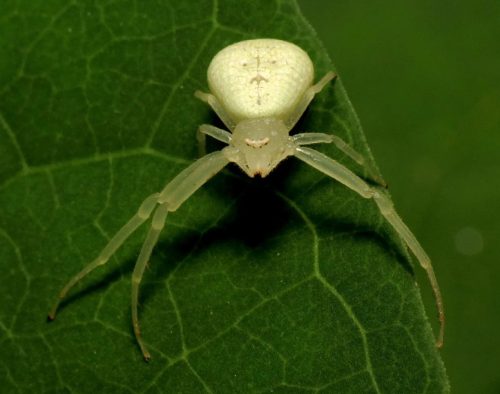
The American Green Crab Spider, scientifically identified as Misumessus oblongus, earns its name from its striking green hue, accentuated by an orange arrow-shaped mark on the abdomen. Upon closer examination, the abdomen appears perforated, adding to its distinctive features. Belonging to a group capable of crab-like movements, these spiders can navigate sideways and backward. Unlike traditional web-spinners, they opt for climbing green vegetation to hunt prey. The green color serves as effective camouflage, rendering them nearly invisible to unsuspecting insects. After mating, females diligently lay egg sacks, often attaching them to vegetation, though they may also be concealed on the ground or nestled within a curled leaf.
Cucumber Green Spider
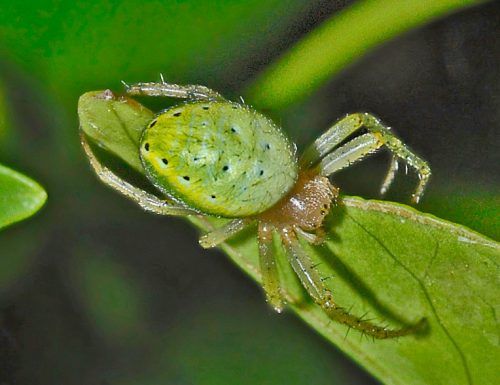
The Cucumber Green Spider, scientifically known as Araniella cucurbitina, is a common presence in the Northern Hemisphere, typically measuring between 4 and 9.5mm in size. Distinguished by its green body, the cephalothorax displays a green-brown shade, while the legs and abdomen exhibit a vibrant green color adorned with small black spots. The ventral side of these spiders features black and yellow markings on the abdomen. Known for constructing expansive spider webs, diligently repaired each night, these arachnids prefer to inhabit green leaf flowers and vegetables like cucumbers. Their green hue serves as effective camouflage, making them challenging for potential prey to detect.
Triangle Crab Spider
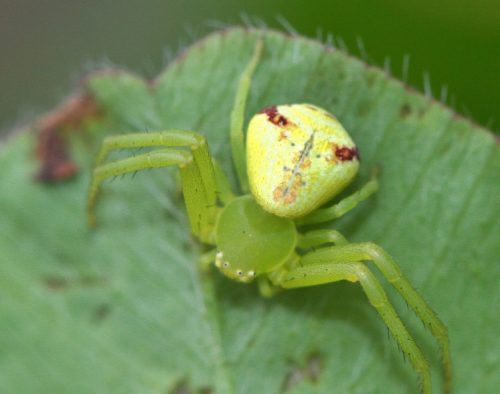
The Triangle Crab Spider, scientifically named Ebrechtella tricuspidata, earns its name due to its crab-like leg positioning. Distinguished by gender-specific coloring, females showcase dominant green hues on the cephalothorax and legs, along with green-yellow tones on the abdomen. In contrast, males feature a less refined green abdomen with white marks, complemented by brown legs and a brown cephalothorax. With a brief lifespan, these spiders are observed only from May to June for males and from May to September for females. Despite their small size, both genders contribute to the diverse array of North American spiders, with males reaching 2.5 to 3.5mm.
Diaea Livens
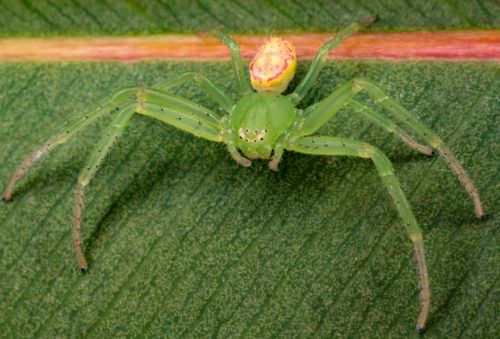
Diaea Livens is a common spider found in woodlands near coastal areas in Europe and California. Individuals of this species are observed in both green and brown colors. The green variant features matching green legs and a contrasting off-white abdomen. Spiders belonging to this species may display several red or black dots distributed across their bodies, adding to the visual diversity of this arachnid in its habitat.
Green Huntsman Spider
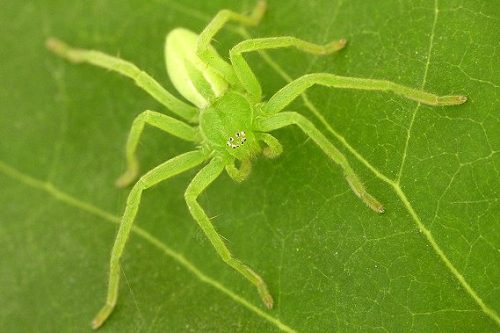
The Green Huntsman Spider, scientifically labeled Micrommata virescens, is a prevalent green spider in Northern Europe. Notably, females exhibit a consistent green color, while males boast a darker green shade with a yellow-green abdomen. Both genders feature vivid green legs. Renowned for their predatory habits, these spiders forego web-building, relying on their camouflage green hue to stalk and capture insects amid dense green vegetation. The Green Huntsman Spider’s name aptly reflects its adeptness in hunting and thriving within natural green environments in Northern Europe.
Eurasian Green Crab Spider
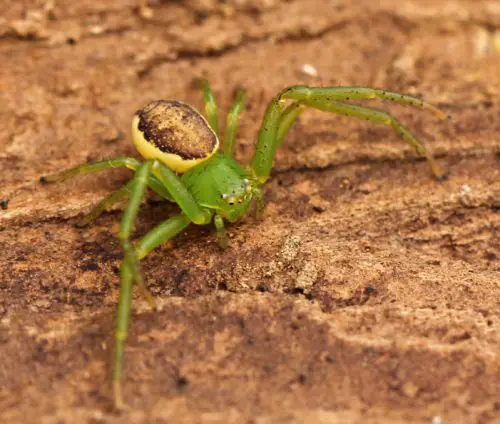
The Eurasian Green Crab Spider, scientifically termed Diaea dorsata, boasts a distinct partially-green body. Featuring a green cephalothorax and legs adorned with short, white bristle-like hairs, these spiders exhibit a dome-shaped abdomen. Females showcase a yellow abdomen with brown marks, while males sport a green-yellow hue. Notably, yellow marks surround their eyes. The initial green color undergoes transformations in adulthood, allowing the spider to adjust its camouflage. While this process may take time, the Eurasian Green Crab Spider adeptly enhances its capacity to blend into its surroundings. Male adults are visible until mid-summer, while females, with a longer lifespan, may persist until mid-fall.
Micrommata Ligurina
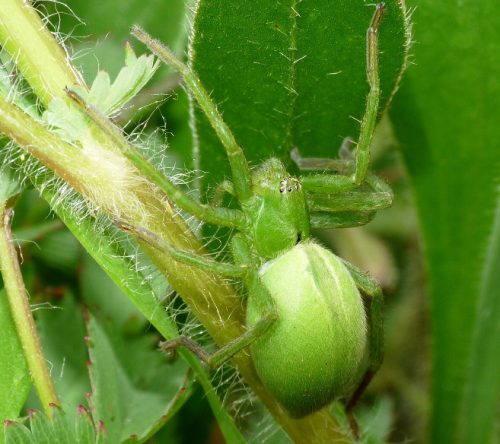
Micrommata Ligurina, known for its distinctive green body and legs, showcases various shades of green along with short white hairs on the legs and short black hairs along the body. With a dark green cephalothorax and a pale green, dome-shaped abdomen containing fewer black hairs, this genus of spiders thrives in dense vegetation across Europe and Northwest Africa. While some individuals may grow up to 8mm, the typical size for most is between 2.5-4mm, making them a modest-sized yet visually striking presence in their natural habitat.
Green Jumping Spider
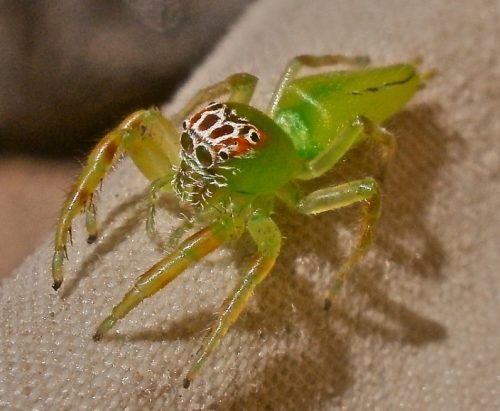
The Green Jumping Spider, scientifically named Mopsus mormon, displays an almost uniform green color, accentuated by brown patches on the legs for males. Distinguishing between male and female coloring is feasible only during the mating season, as these spiders typically lead solitary lives. Females initiate mating when males enter their nests. Interestingly, some female Green Jumping spiders may also choose to mate outside the nest, exercising selectivity in choosing their male partners. This behavior adds an intriguing dynamic to the reproductive strategies of these agile and vibrant arachnids.
Green Meshweaver
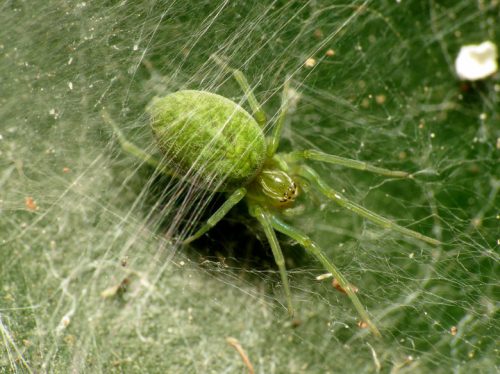
Green Meshweaver spiders, scientifically identified as Nigma walckenaeri, commonly inhabit gardens and private parks. Renowned for their vibrant green coloring, these spiders primarily prey on moths. Minimal color distinctions exist between males and females, both featuring vivid green hues and Chevron-like yellow marks on the abdomen. The legs share the green color but are slightly lighter. While not highly proficient web builders, Green Meshweavers construct small webs for concealment, often found in decorative garden flowers and bushes like ivy. These spiders are most active and visible during the spring and summer seasons.
Speckled Orbweaver
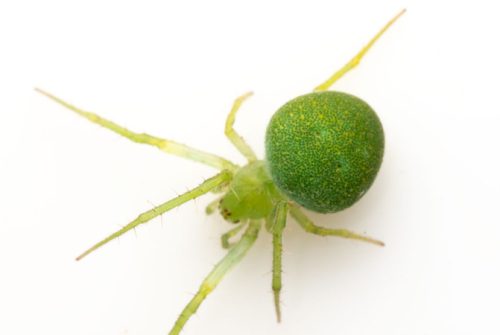
The Speckled Orbweaver, scientifically labeled Araneus circulissparsus, thrives as a common green spider amid dense vegetation. Growing up to 4.5mm, it exhibits variations centered around a green color scheme, encompassing the cephalothorax, legs, and abdomen. Some spiders in this genus sport two eye-like brown and yellow marks on each side of the abdomen, occasionally connected by a line. Another variant features a brown abdomen adorned with green and yellow marks. These morphs represent adaptive strategies enhancing the Speckled Orbweaver’s camouflage within its leafy green environment, showcasing nature’s ingenuity in spider adaptations.
Slender Green Orbweaver
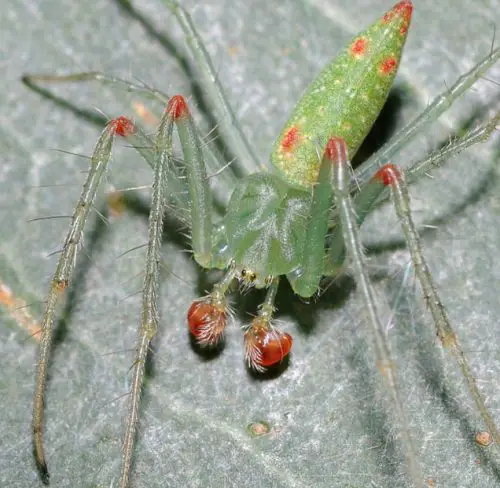
The Slender Green Orbweaver, scientifically named Araneus talipedatus, is a prevalent spider species distinguished by its green coloring. The females feature a predominantly green cephalothorax, abdomen, and legs, complemented by a distinctive white central line on the abdomen flanked by two red lines. Males may display red markings on the abdomen in the form of connected dots rather than parallel lines. Some morphs showcase a yellow abdomen with red lines on the sides and red marks on the legs. Typically associated with eucalyptus habitats, these spiders spend their days concealed in these surroundings.
Lozenge-Shaped Crab Spider
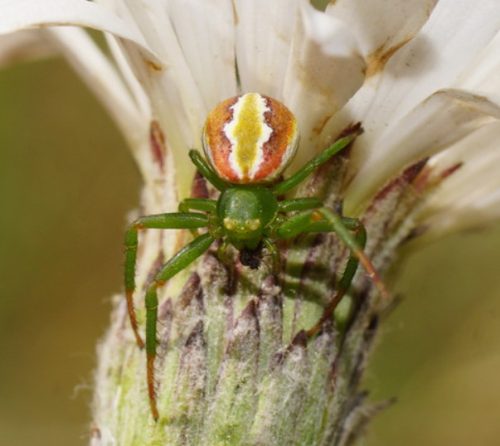
The Lozenge-Shaped Crab Spider, scientifically termed Australomisidia pilula, prevails in the green spectrum within its spider family, particularly common in Australia. Featuring a green cephalothorax and dark red legs, its distinguishing characteristic is a brown-red abdomen adorned with white lines along the body. Both males and females exhibit slight color variations, with females showcasing lighter colors on the abdomen, sometimes yellow instead of brown-red. Notably, females may bear red-brown marks in the central abdomen when the base color is yellow. Environmental adaptations extend to leg coloring, with some spiders having all-green legs and others displaying a mix of green and brown, enhancing their camouflage to mimic host plants.
Kidney Garden Spider
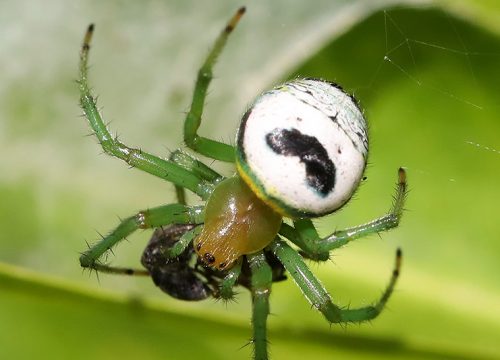
The Kidney Garden Spider, scientifically termed Bijoaraneus mitificus, is renowned for its unique habitat—a small spider web crafted inside curled leaves. Displaying vivid green coloring, these spiders feature a green cephalothorax and a distinct white, globular-shaped abdomen. Similar in size to the Tiny Green Huntsman Spider, they reach a maximum size ranging between 3 and 5mm. This diminutive yet colorful spider adds a touch of intrigue to its surroundings, utilizing curled leaves as both a shelter and a hunting ground for insects.
Long-Jawed Orbweaver
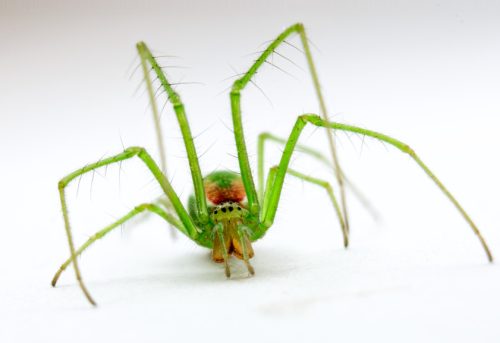
The Long-Jawed Orbweaver, scientifically named Tetragnatha viridis, is a petite green spider commonly found in pine or fir forests. Despite its elongated mouthparts capable of biting, this species is neither venomous nor aggressive toward humans. With elongated legs adorned with short black hairs and yellow to red mouthparts, the cephalothorax is green, while the abdomen displays green on the lower part and yellow and brown on the upper side, marked by white lateral lines. Characterized by two rows of eyes, its vision is limited, relying on the ability to sense spider web vibrations to detect potential prey. Some color variations, including rare golden abdomen spiders, have been reported, particularly in fir environments.
Green Orbweb Spider
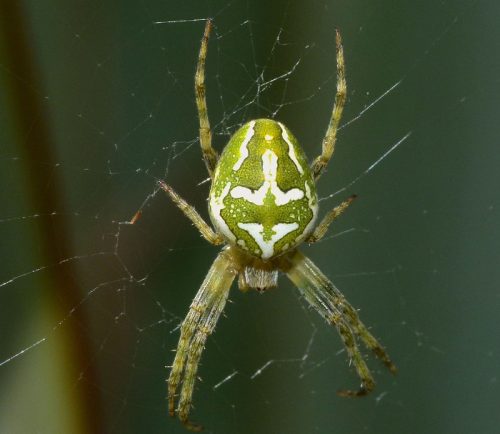
The Green Orbweb Spider, scientifically identified as Colaranea viriditas, is a familiar sight in gardens, having spread worldwide with the import of flowers. Exhibiting various color variations, all morphs feature a significant green hue. The common morph entails a translucent green cephalothorax and legs, accompanied by a bright green abdomen bordered by white lines. Another version boasts a green abdomen with red legs and a red cephalothorax. Gardens may host combinations of these morphs, including spiders with red legs, a green cephalothorax, and a green abdomen adorned with yellow marks. These spiders spend their days hanging upside-down on webs, relying on their sense of touch rather than vision to detect and capture prey.
Red-Spotted Orbweaver
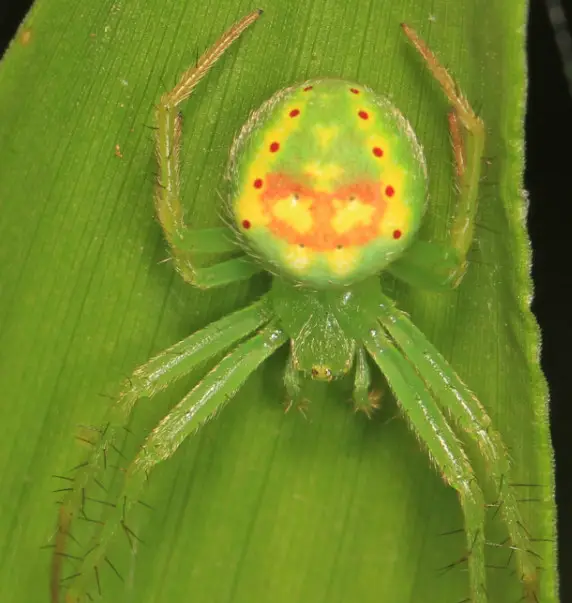
The Red-Spotted Orbweaver, scientifically known as Araneus cingulatus, earns its name from the distinctive red spots adorning its mostly green abdomen. With a light green cephalothorax and a dark green abdomen featuring red dots, parallel white, and yellow lines, these spiders boast green legs adorned with long black hairs, enhancing their camouflage capabilities. Commonly inhabiting trees, especially in gardens, their green color provides effective concealment. Active during the day, these spiders, imported from Europe, contribute to the ecological diversity of their new habitats, often proving challenging to spot due to their adept camouflage in tree environments.
Elongate Green Crab Spider
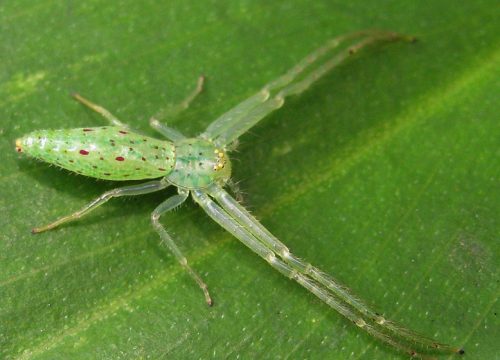
The Elongate Green Crab Spider, scientifically named Oxytate virens, is recognized for its consistent green coloring. Characterized by elongated front legs and shorter rear legs, these spiders sport an almost transparent green hue with a single yellow mark atop the head. Native to Southeast Asia, they have also been introduced to the Eastern US. Despite their name, identifying them can be challenging, as they don’t closely resemble crabs except for their elongated front legs. Typically found in trees, especially in Southeast Asia, they adeptly blend into green leaves, making them inconspicuous to casual observers.
Red-Tipped Crab Spider
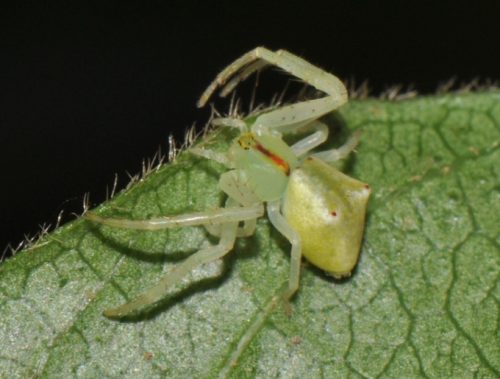
The Red-Tipped Crab Spider, scientifically termed Sidymella rubrosignata, hails from Australia but has become increasingly prevalent globally, spreading through the flower trade, particularly on Dianella flowers exported by Australia and New Zealand. Primarily green, occasionally displaying red accents, these spiders exhibit a uniform green body and legs, with a brighter green-yellow abdomen. Operating without webs, they perch on Dianella flowers, waiting for insects to approach, utilizing their crab-like ability to move sideways and backward. Interestingly, in Southeast Asia, these spiders may adopt red or brown hues while on Dianella flowers, showcasing their adaptability to different environments within the broader spider group.
Tiny Green Huntsman Spider
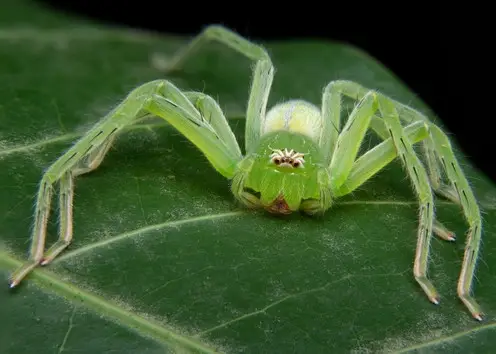
The Tiny Green Huntsman Spider, scientifically named Gnathopalystes taiwanensis, may not hunt prey as large as its counterparts, but it is prevalent in tropical regions globally. Exhibiting a uniform green color, with a slightly brighter green abdomen, these spiders commonly reside on leaves, where they feed on insects throughout both day and night. Despite their diminutive size, they play a significant role in maintaining ecological balance in their tropical habitats by contributing to insect control in their leafy environments.
Epeus Glorius
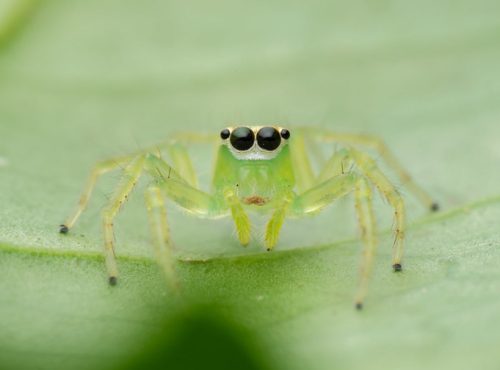
Epeus Glorius, belonging to the Epeus group of spiders, predominantly inhabits Japan and nearby regions of China. Adapting to its floral environment, this spider adopts the green coloration of flower leaves. Characterized by a green body adorned with brown and white marks, Epeus glorius stands out with distinctive markings limited to its cephalothorax. Positioned on flowers, these spiders patiently await prey, primarily targeting insects that feed on flower nectar. Distinguished within the genus by similar-length front legs, Epeus spiders feature short white hairs on these legs, setting them apart from their counterparts with whiter and black hairs.
Indian Green Lynx Spider
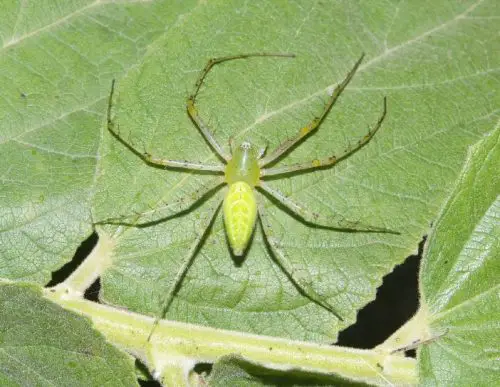
The Indian Green Lynx Spider, scientifically identified as Peucetia viridana, is recognized for its green body adorned with yellow stripes. Deployed in cotton fields for pest control, their green camouflage renders them nearly invisible to incoming moths. Varying in size, these spiders can reach a maximum body length of 22mm. Despite their agricultural benefits, they are known to bite. Although non-venomous, their bites can induce allergic reactions, with mild symptoms such as edema. Notably, large edemas of up to 22 inches have been reported following bites from the Indian Green Lynx Spider.
Northern Lined Hygropoda
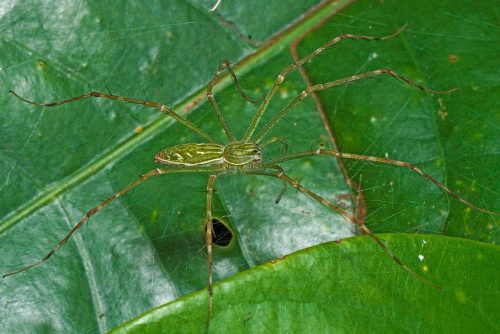
The Northern Lined Hygropoda, scientifically known as Hygropoda lineata, is a common sight near water sources in Australia. With an average size of 11mm, this species exhibits sexual dimorphism, with males being brown and females featuring a green body adorned with white vertical stripes. These distinctive stripes extend across their body and legs, accompanied by black hairs. Preferring upturned green leaves, these spiders construct small webs within, living in close proximity to water sources where they primarily feed on insects, including mosquitoes, contributing to the ecological balance of their habitats.
Tailed Jumper
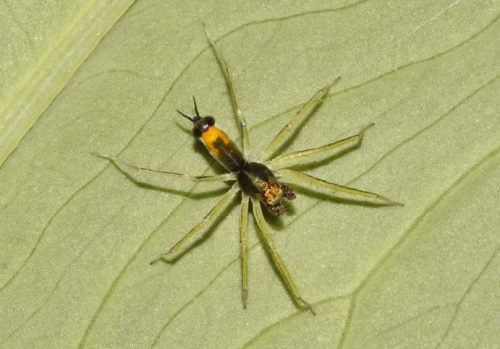
The Tailed Jumper, scientifically named Asemonea tenuipes, showcases gender-based color variations. Females exhibit a green abdomen, cephalothorax, and legs, with a distinguishing white mark on the head. In contrast, males possess an elongated ant-like body, characterized by a black color adorned with red markings on the head and abdomen. Frequently spotted on the underside of leaves, both males and females engage in mating and egg-laying activities, contributing to the intriguing dynamics of this species within plant environments.
Green-Pea Spider
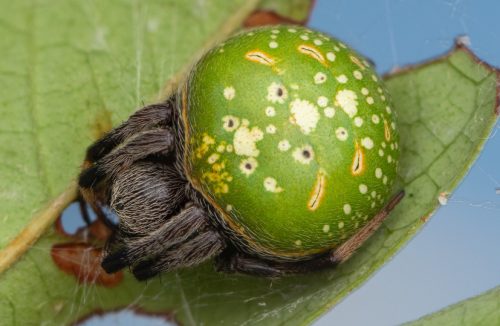
The Green-Pea Spider, scientifically termed Araneus apricus, derives its name from the striking vivid green abdomen, set off by a brown-red cephalothorax and legs. Characterized by a vibrant green abdomen adorned with five small dark spots and several fainter yellow spots, the contrasting dark color of the rest of its body enhances its camouflage. Native to South Africa, this spider eludes easy observation by hiding within or under leaves. Primarily nocturnal, the Green-Pea Spider prefers rest during the day, adding an element of mystery to its habits within its natural habitat.
Okinawa’s Green Crab Spider
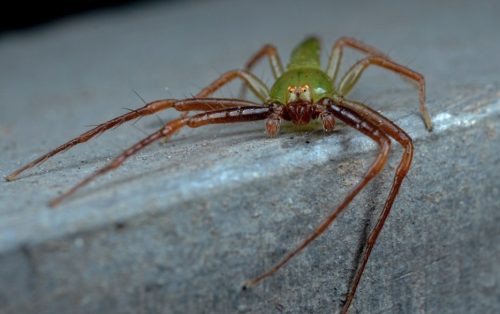
Okinawa’s Green Crab Spider, scientifically known as Oxytate hoshizuna, is widespread in Asia, Europe, and South Africa, with its range expanding globally. These spiders, belonging to a webless genus, rely on their uniform camouflage green color to ambush insects rather than constructing webs. Notably, this spider family possesses a translucent body capable of reflecting UV light. This unique ability is believed to be advantageous in guiding bees to flowers or attracting more bees to specific blooms, highlighting the intricate ways in which these spiders interact with their environment.
People Who Read This Also Read:

